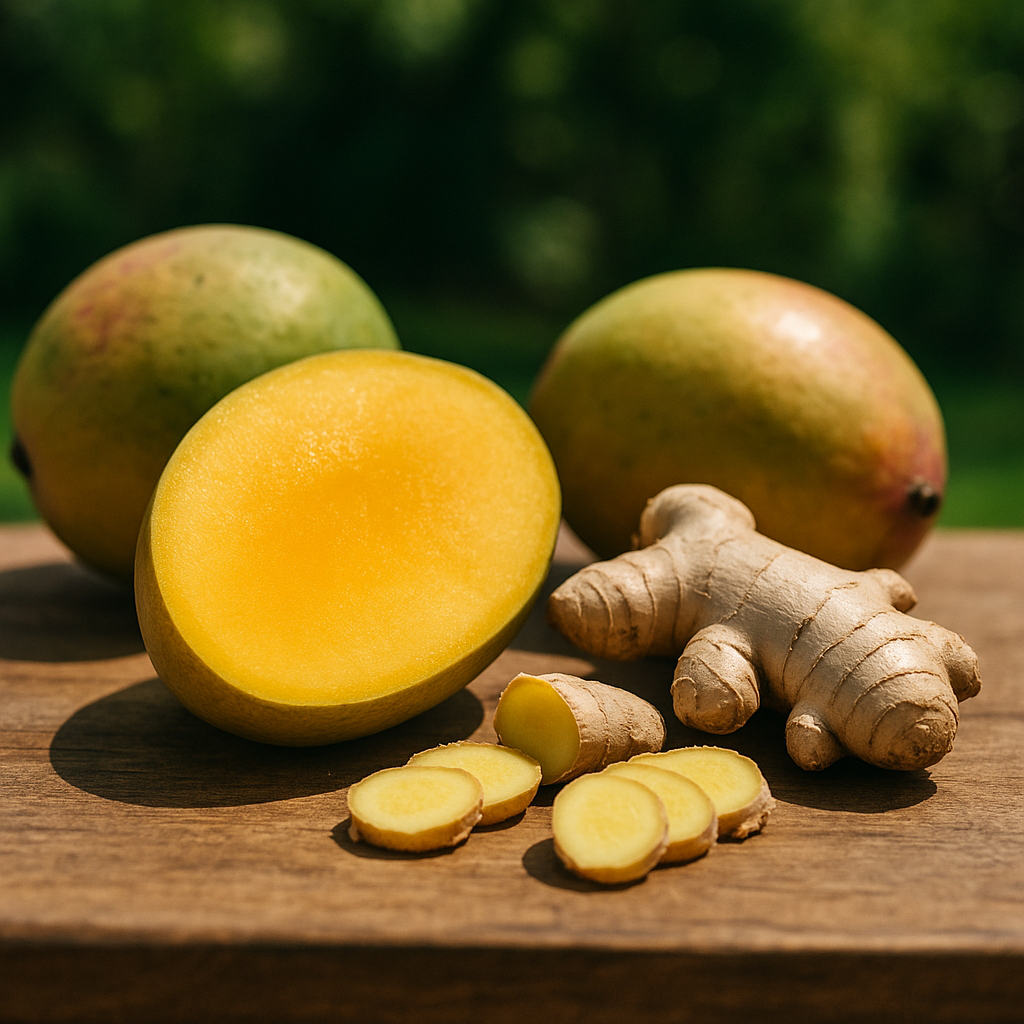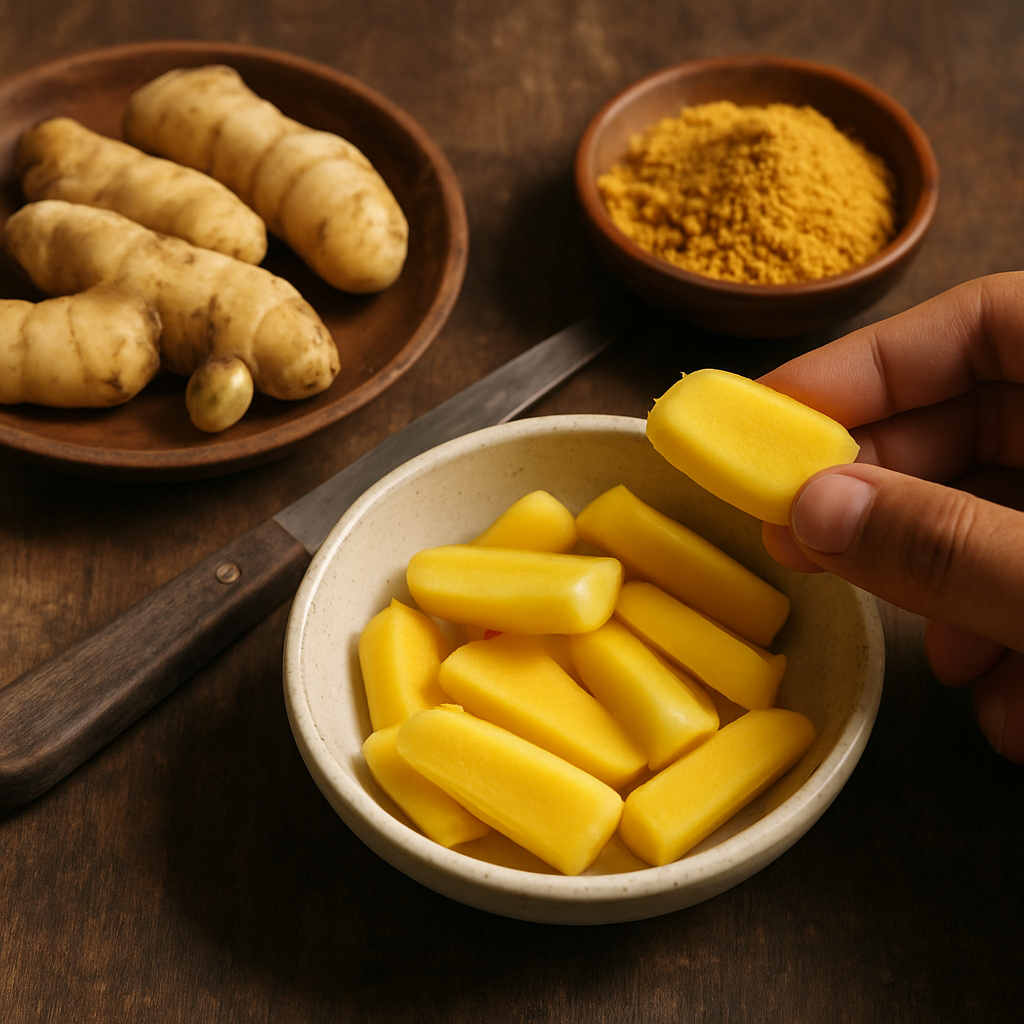Ask Ayurvedic doctor a question and get a consultation online on the problem of your concern in a free or paid mode. More than 2,000 experienced doctors work and wait for your questions on our site and help users to solve their health problems every day.
Shop Now in Our Store
What Is Mango Ginger? Ayurvedic Guide to Benefits, Tea, and Usage

If you've ever stumbled across the curious-sounding term mango ginger, you're not alone. It's not quite mango, not quite ginger — so what is mango ginger exactly? Surprisingly, it's a rhizome (root) that looks like ginger, smells a bit like raw mango, and boasts a range of health and culinary benefits that have been praised in Ayurveda for centuries. Packed with antioxidants, digestive-friendly compounds, and skin-loving properties, this under-the-radar superfood is finally stepping into the spotlight.
So whether you're here to learn about mango ginger benefits, figure out the best uses of mango ginger, or you're just wondering can we use mango ginger in tea — you're in the right place. This article explores it all: what it is, how it's different from regular ginger, its role in ancient Ayurvedic practices, mango ginger tea, and even potential side effects of mango ginger that you should be aware of.
Let’s dive in!
What Is Mango Ginger in Ayurveda?
In Ayurvedic tradition, mango ginger — also known as Curcuma amada — holds a unique place among healing herbs. Though it resembles common ginger (Zingiber officinale), mango ginger is actually more closely related to turmeric, believe it or not. It’s often used in Ayurveda for balancing pitta and kapha doshas due to its cooling, calming nature.
Unlike fiery ginger, which heats the body, mango ginger is soothing. It’s used in poultices, digestive tonics, and skin treatments — especially in southern parts of India, where it's part of daily life in both kitchens and home apothecaries.
Mango Ginger vs Ginger: What’s the Difference
Here's where people often get tripped up: mango ginger and regular ginger look almost identical from the outside. Both are knobbly, beige rhizomes. But once you slice them open, the difference is clear. Mango ginger has a pale yellow interior and a crisp texture, with a fragrant, tangy aroma reminiscent of raw mangoes — hence the name.
Taste-wise? Regular ginger is spicy and pungent, often overpowering in large doses. Mango ginger is milder, slightly sweet, with a hint of mango-like acidity that makes it perfect for pickling or blending into refreshing teas.
Medicinally, they serve different purposes too. Ginger is heating and great for warming the body, fighting cold symptoms. Mango ginger, on the other hand, is more soothing and anti-inflammatory without the bite. That makes it ideal for sensitive stomachs or skin-related remedies.
Appearance, Taste, and Properties of Mango Ginger
The color of mango ginger can range from cream to light yellow, and it has a smooth skin compared to the rougher ginger root. It snaps cleanly when broken, and the smell — it's hard to forget. Somewhere between citrus, mango peel, and fresh earth.
From a health perspective, mango ginger is loaded with bioactive compounds like curcuminoids (just like turmeric), flavonoids, and essential oils. These contribute to its antioxidant, antibacterial, and anti-inflammatory properties — all central to its traditional uses.
And yep, it’s not just used in Indian cooking; some Southeast Asian cultures use it too. But in Ayurveda, it has long been a staple — whether dried and ground into powder or sliced and steeped into decoctions. So... not only tasty, but time-tested.

Mango Ginger Benefits for Health and Wellness
Let’s talk benefits. Mango ginger isn’t just a pretty name — it’s packed with healing potential. For centuries, it's been used to calm the gut, cool inflammation, and even promote glowing skin. These benefits of mango ginger are rooted in both tradition and science, making it a valuable ally for modern wellness too.
Benefits of Mango Ginger for Digestion and Inflammation
Struggling with bloating, indigestion, or that sluggish post-meal fog? Mango ginger might help. Known for its carminative and anti-flatulent properties, it aids digestion gently without the spicy punch of regular ginger.
Unlike its spicy cousin, mango ginger has a cooling effect on the body — which is perfect if your digestive issues are linked to excess heat (hello, Pitta imbalances!). It helps to calm stomach spasms, support bile production, and promote smoother digestion overall.
Also, inflammation. It’s at the root of so many modern illnesses — from joint pain to chronic fatigue. Mango ginger contains natural anti-inflammatory compounds, including curcuminoids, which help reduce internal swelling and ease discomfort. This makes it useful not only for gut health but also for folks with arthritis or skin flare-ups like eczema.
One small 2020 study from India (don’t quote me on the exact title — I misplaced the link 🙈) even noted a significant drop in inflammatory markers in participants who consumed mango ginger extract regularly for four weeks.
Mango Ginger Benefits for Skin and Internal Detox
Your skin often reflects what’s going on inside, right? That’s why detoxifying herbs like mango ginger are gold in Ayurveda. Thanks to its antioxidant content, mango ginger helps cleanse the liver and blood, supporting natural detox processes. When your insides are clear, your skin tends to glow. True story.
Now, when it comes to mango ginger benefits for skin directly, here’s where it gets interesting. Traditional face masks in South India often include mango ginger paste — it’s believed to soothe acne, reduce redness, and calm sensitive skin. Its natural antimicrobial properties also make it a gentle yet effective ingredient for managing breakouts.
And while there’s not tons of Western research on it yet, anecdotal evidence and Ayurvedic wisdom strongly support these uses. It’s not a miracle cure, but definitely a worthwhile addition to your skincare and wellness routine.
You can also consume it in various forms — raw slices, powders, or teas — to support gentle detox. Just don’t overdo it (more on that when we talk about mango ginger side effects later).
Common Mango Ginger Uses in Daily Life
Alright, now you’re probably thinking: “Cool, but how do I actually use mango ginger?”
You’re in luck — it’s pretty versatile. From spicing up your meals to sipping it in teas, there are so many uses of mango ginger that feel both practical and enjoyable.
Uses of Mango Ginger in Ayurvedic Cooking and Home Remedies
In Indian households, mango ginger is often used in pickles — its tangy flavor holds up well when preserved. But that’s not all. You’ll also find it in chutneys, spice pastes, and even infused oils. It’s especially popular during monsoon season, when digestive troubles tend to rise.
Ayurvedic remedies also use mango ginger for everything from nausea relief to joint massage oils. It’s gently rubbed on aching joints or temples to reduce swelling and tension.
One quirky home remedy involves boiling mango ginger slices in milk with a pinch of turmeric and black pepper. Sounds weird, but it’s a surprisingly soothing nightcap.
Can We Use Mango Ginger in Tea or Herbal Infusions?
Absolutely. In fact, mango ginger tea is one of the easiest and most effective ways to enjoy its benefits.
Just slice a few thin pieces of fresh mango ginger, toss them in boiling water, and let it steep for 10–12 minutes. Add lemon or honey if you like. It’s fragrant, refreshing, and surprisingly cooling — great for summer afternoons or post-meal sips.
So to answer the question — can we use mango ginger in tea? — 100% yes.
It’s an easy, low-effort way to tap into the detoxifying and digestive benefits without needing a mortar and pestle or complicated prep. Just steep and sip.

Mango Ginger Side Effects and Precautions
While mango ginger is generally considered safe and gentle, like anything in wellness, moderation is key. And yep — mango ginger side effects are real, even if they're rare.
Most people can enjoy it without any issues, but here are a few things to watch out for:
-
Allergic Reactions: If you're allergic to ginger, turmeric, or other members of the Zingiberaceae family, you might react to mango ginger too. Start small if it’s your first time.
-
Digestive Upset: Ironically, while it helps digestion, overconsumption (especially in raw form) can lead to loose stools or mild stomach cramps. So don’t go overboard.
-
Skin Sensitivity: Applying mango ginger paste topically is popular in Ayurveda, but patch test first. Some people have reported mild itching or redness, especially with sensitive skin.
Also, if you're pregnant, breastfeeding, or on medications (like blood thinners or anti-inflammatories), check with your doctor before consuming large amounts. It's natural, sure, but still potent. Nature packs a punch.
So, in short: enjoy mango ginger, but don’t treat it like candy or chug mango ginger tea all day long. A little goes a long way.
Conclusion
Mango ginger is one of those hidden gems in the world of healing herbs — packed with benefits, deeply rooted in tradition, and surprisingly versatile. From easing digestion and reducing inflammation to helping skin detox naturally, the benefits of mango ginger are both broad and meaningful.
Its gentle flavor makes it easy to add to your routine — whether through herbal teas, Ayurvedic dishes, or even DIY skincare. And while there are some mild mango ginger side effects to be aware of, it's generally well tolerated by most folks.
So next time someone asks you, “what is mango ginger?” — you’ll know exactly what to say. And hey, you might even convert a few people to the mango ginger fan club. (We’re friendly. And slightly obsessed.)
✅ Final tip?
Try starting with mango ginger tea 2–3 times a week. It’s an easy way to get started, especially if you’re not sure how to cook with it yet. Just remember: keep it simple, listen to your body, and enjoy the journey.
FAQs
Can I drink mango ginger tea daily?
Technically, yes — but it’s best to start slowly. 2–3 cups per week is a good baseline. Daily use is usually safe for most people, but watch for digestive changes or allergic reactions. If anything feels off, take a break.
What are the benefits of mango ginger for the skin?
Mango ginger has anti-inflammatory and antibacterial properties that can help calm acne, reduce redness, and support clearer skin. It’s used both internally (through teas or powders) and externally in masks or poultices in traditional Ayurvedic remedies.
Are there any side effects of mango ginger?
Yep, though they're uncommon. Possible side effects include digestive discomfort, allergic reactions (especially for those sensitive to ginger or turmeric), and mild skin irritation when applied topically. Always start with small amounts and monitor how your body reacts.
🌿 Want to get started with mango ginger?
Try making a simple mango ginger tea this week, or look for it at your local spice market. If you’re into holistic skincare or clean eating, this root might become your new go-to.
And hey — if you found this helpful, share it with a friend who loves natural remedies or is always on the hunt for underrated superfoods.
Stay curious, and stay well. 🧡
This article is checked by the current qualified Dr Sujal Patil and can be considered a reliable source of information for users of the site.

